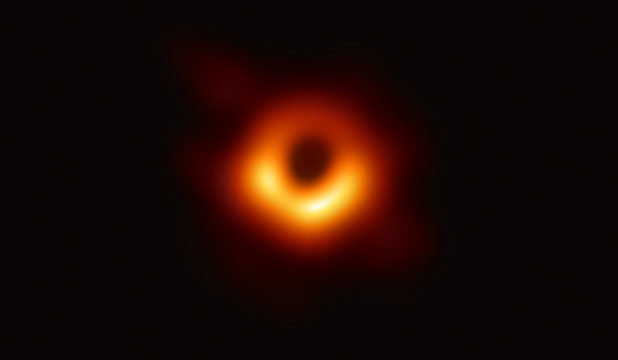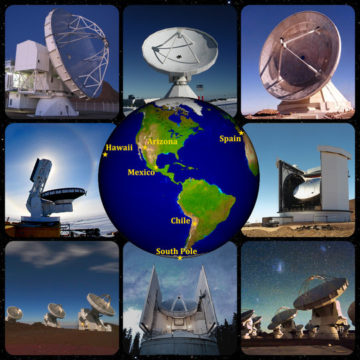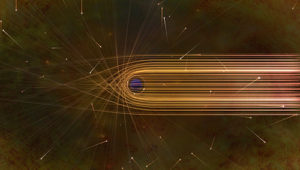The Event Horizon Telescope collaboration has reconstructed the shadow of a supermassive black hole.
Scientists have at last “seen” a black hole — and it’s beautiful.
Announcing the result at a National Science Foundation press conference in Washington, D.C., representatives of the Event Horizon Telescope collaboration unveiled a reconstructed image of the gargantuan black hole in the giant elliptical galaxy M87. The galaxy lies about 55 million light-years away in the constellation Virgo. The black hole itself is so large that light would take 1½ days to cross it.
“We have seen what we thought was unseeable,” said project director Sheperd Doeleman (Center for Astrophysics, Harvard & Smithsonian) during the press conference. “We have seen and taken a picture of a black hole. Here it is.”

Event Horizon Telescope collaboration
Unmasking the Invisible
Capturing a black hole’s visage requires far more than just a point-and-shoot approach. The worldwide team of researchers, comprising 200 people from some 20 countries, constructed the black hole’s image using a technique called very long baseline interferometry (VLBI). VLBI combines the data from multiple radio telescopes scattered across the globe to create a virtual, Earth-sized dish, with a resolution equivalent to being able to read the date on a quarter in Los Angeles seen from D.C., Doeleman said.
Think of the old joke about a bunch of blindfolded scientists studying different parts of an elephant — one finds an ear, another the tail, and so forth. With VLBI, each blindfolded scientist represents the distance, or baseline, between two telescopes. But instead of sampling different body parts, each baseline observes a different scale of the elephant: One says it’s 10 feet high; another says there’s an ear here of such-and-such size; still another explores the fine texture of the elephant’s skin. As Earth turns, the baselines change, detecting different scales of the elephant. The scientists then piece these bits of information together into a coherent image.

© APEX, IRAM, G. Narayanan, J. McMahon, JCMT / JAC, S. Hostler, D. Harvey, ESO / C. Malin
Although the black hole image released today and reported in six papers in the Astrophysical Journal Letters is based on only four days of observations, EHT scientists spent years testing and installing equipment, working in the thin air of the remote Chilean desert, braving the cold of Antarctica. They built computer algorithms and developed simulations of what they might see. They did dry runs, agonizing over go/no-go weather conditions at eight telescopes at six geographic sites scattered from Hawai‘i to Spain and Arizona to the South Pole. “In VLBI, you really only get one shot,” said Dan Marrone (University of Arizona), who has flown repeatedly to the South Pole to retrofit the telescope there. “Everything has to be working exactly right.”
Then, in April 2017, they went for it.
As Earth turned, each telescope set its sights on M87 and the other targets, stockpiling data. By the end of the observing run, the observers had filled a half ton of hard drives with 5 petabytes of data — the equivalent of 5,000 years of MP3 files, or, Marrone quipped, “the entire selfie collection over a lifetime for 40,000 people.”
The team then flew these hard drives to Massachusetts and Germany, where the eight stations’ observations were fed into supercomputers and aligned to within trillionths of a second. “They have to be exactly right,” says Michael Johnson (Center for Astrophysics, Harvard & Smithsonian), who helped coordinate the imaging data analysis. “If they’re even a tiny bit off, you see nothing.”
The Shadow Knows
All these tribulations they tackled in order to detect the tiny silhouettes of distant supermassive black holes.

Nicolle R. Fuller / NSF
As gas swirls around a black hole and dives deeper into the pit the black hole creates in spacetime, it heats up, emitting light across the electromagnetic spectrum, from X-rays to radio, explains EHT astronomer Feryal Özel (University of Arizona). Very close to the black hole’s event horizon, these photons can become temporarily trapped, looping around and around the black hole in what’s called a photon ring before escaping and reaching our telescopes. As the glowing gas continues to fall in, though, it will plunge past the event horizon, and its light will never reach us. These effects combine to create what’s called the black hole’s “shadow”: a dark circle surrounded by a bright ring. It looks a bit like a glazed doughnut.
Once the researchers had calibrated their data, a subset of them (mostly young astronomers and computer scientists just starting their careers) split into four teams. “We told them, ‘Don’t talk to each other or anyone else,’” said Marrone. “‘Choose whichever imaging algorithms you think are best, and make images of these data.’”
“We went into a room, there were six or seven of us there,” says Johnson, “and we actually had the first picture 30 minutes later.”
The challenge isn’t making one image, he explains, but understanding its subtleties. The teams had to know all the potential images their algorithms might create and where the codes might lead them astray. After testing the countless alternatives, they all met and unveiled their four images — and all looked remarkably alike: four dark circles surrounded by ringlike structures.
Then the team members reorganized themselves, using what they’d learned to systematically attack each day’s data three different ways. Each method produced a slightly different image, but once again, the images were strikingly consistent with one another.
Combining these images into a single one took a long, long time, Johnson says. The researchers wrestled with how to convey what was sure versus what might be the byproduct of a single algorithm’s favorite bits. They finally decided to combine the four images and blur the result to match their instruments’ resolution. By doing so, they only showed the structure that appears using all four methods. “We stand behind basically every element” of this conservative image, he says.
And what an image it is. The width of the silhouette is about 40 microarcseconds — the size of a thumbnail seen from 40,000 miles away. “This is the first time that I saw this image,” said NSF Director and astrophysicist France Córdova, “and it did bring tears to my eyes.”
Around the Rabbit Hole

NASA / The Hubble Heritage Team
The team’s primary focus for today’s announcement was creating the image. But they have ascertained some of the underlying physics, too. Based on the size of the shadow, the researchers calculated the black hole contains 6.5 billion solar masses, a figure close to the larger of two contested values.
The black hole is spinning clockwise from our perspective; the bright crescent to the south is the boosted beam of gas moving toward us, while the dimmer north is where gas recedes from us. The data do not, however, reveal how quickly the black hole spins, because the shadow’s shape and size are independent of the spin except for the most extreme rotations.
The image also gives astrophysicists a huge boost of confidence in their theories about what happens near an accreting black hole. “I have to admit I was a little stunned that it matched so closely the predictions we had made,” said Avery Broderick (Perimeter Institute and University of Waterloo, Canada).
“Just the fact that our [simulations] came so close to images like the one we ended up getting for M87 already tells us that we’re on the right track for understanding accretion physics,” says Özel. “We could have been completely off.”
Soon, the researchers will start putting together maps of how the magnetic fields — crucial for powering jets like the one M87’s black hole spews forth — move near the event horizon. They also will be analyzing their observations of our own galaxy’s central black hole, Sagittarius A*. Although many expected today’s result to be about Sgr A*, not M87, our black hole will take more time: Because it’s about a thousandth the mass of M87’s black hole, Sgr A* is smaller, and gas whips around its circumference a thousand times faster. That means we see much faster changes in its light, making teasing apart the shadow signature more complex. “We knew it was a more turbulent child,” says Özel. “We have to apply special care.”

The team is already working on pushing to a slightly shorter wavelength than the 1.3 mm currently used, which will boost their resolution considerably. But M87 and Sgr A* are the only two black holes whose shadows we can detect with ground-based networks. To expand to a larger number of black holes, they’ll have to put radio telescopes in space. Adding geosynchronous orbits would lengthen baselines by more than six times Earth’s radius, enabling the EHT to see black hole shadows roughly one-tenth as wide as M87’s.
I first met Doeleman nearly 10 years ago, when writing my master’s thesis on black holes, and like many others I caught his visionary enthusiasm. Over the years, I’ve watched the team face many setbacks and frustrations. “I didn’t realize how hard it would be when we started out,” Doeleman says, thinking back on the journey. But he was indefatigable. “You know, there are just some projects that you have to keep pushing on, no matter what.” That they’ve seen a black hole’s shadow — when they could have just seen yet another blob, or something unexpected — is mesmerizing, humbling, and a testament to the years of everyone’s hard work. Or, as he puts it: “Sometimes you have to kiss a lot of frogs before you get the prince.”
References:
The Event Horizon Telescope Collaboration. “First M87 Event Horizon Telescope Results. I-VI.” Astrophysical Journal. April 10, 2019.
Dimitrios Psaltis. “Testing General Relativity with the Event Horizon Telescope.” arXiv.org. June 26, 2018.
NSF press conference. April 10, 2019.
Update: The original version of this story stated the final image is the combination of the initial four images made; it's actually the combination of three images. The sixth paragraph of "The Shadow Knows" is a later addition to correct the explanation.
What is a black hole? Find the answer to this and other questions in our black holes FAQs.
 13
13









Comments
TestFlight
April 11, 2019 at 12:02 pm
This is a very nice article! These are the type of reports that make me glad I subscribe.
You must be logged in to post a comment.
Anthony Barreiro
April 11, 2019 at 4:02 pm
After reading several "gee whiz" stories in the mainstream press about this image, once again I am deeply grateful to Sky and Telescope for a report that is both rigorous about the science and technology and intelligible to an interested lay reader. I'm touched by your personal connection with Sheperd Doeleman. Thank you!
I'm curious about the difference between the Milky Way's supermassive black hole and M87's. M87's is a lot bigger, but also much farther away. A penny held at arm's length easily covers the Moon, even though the Moon is a lot bigger than a penny. Once the data are analyzed, will the image of our own SMBH's event horizon have greater angular resolution than this image of M87?
I've been surprised by how many people have been talking about this image, people who aren't otherwise especially interested in astronomy. Early yesterday morning while doing some impromptu sidewalk astronomy (clear skies, no wind, and good views of Jupiter and Saturn) a woman walking her dog was more interested in talking about the black hole than Jupiter's moons or Saturn's rings (at that time I assumed the image was of the Milky Way SMBH, so I pointed out the galactic center in Sagittarius. I misinformed her about this image, but at least she now knows a bit more about our galaxy). Coworkers were asking me about it at work yesterday. And then last night while sharing views of the Moon another passerby wanted to know about the black hole. I wish I had known to refer them to this article!
For amateurs doing public outreach, M87 would be an excellent target. It's well placed in the evening sky for the next few months, easy to see in moderate apertures, and now it's a celebrity.
You must be logged in to post a comment.
Mario
April 11, 2019 at 9:20 pm
Like you, I was frustrated by the mainstream coverage and turned to S&T. But I find this article unsatisfying...too much human interest and not enough science. Compare with this, which addresses your question directly:
https://aasnova.org/2019/04/10/first-images-of-a-black-hole-from-the-event-horizon-telescope/
You must be logged in to post a comment.
Anthony Barreiro
April 12, 2019 at 7:51 pm
Thanks Mario. This is an interesting report with additional information. It doesn't say anything about expectations for the image of the Milky Way's supermassive black hole. I guess we'll just have to wait and see.
There is a lot of human interest in this story. From the engineers, technicians, and meteorologists who created an interferometer with a baseline equal to the diameter of the Earth to the scientists who devoted a big chunk of their careers and lives to trying to see and understand something that had never been seen before, these are interesting humans!
You must be logged in to post a comment.
tom-dasilva
April 11, 2019 at 6:57 pm
is the bright ring caused by photons bent around the hole, or is it caused by photons radiated from the accretion disk? Seems fortuitous that we'd be looking down the pole of the accretion disk, but maybe not considering the jet is pointed at us.
You must be logged in to post a comment.
PGT
April 12, 2019 at 12:03 am
Kids ask the best questions.
Mine are fascinated by the photo this week of a black hole and wonder what it would look like "inside" a black hole.
I assume that since light can't escape a black hole, the inside would look, well, black.
But would it?
And is there an "inside"?
You must be logged in to post a comment.
Peter Wilson
April 12, 2019 at 1:47 pm
Notice that towards the center, the emissions first brighten, then fade. The reason is that as the gas falls further and further into gravitational well, the photons have to climb further and further "up," stretching them to longer and longer wavelengths. Emissions fade-to-black, from our perspective. But if you rode along with the gas, you would remain in its frame-of-reference, and it would just get hotter and hotter. Your kids' question is like asking what it would look like “inside” the sun. Since we cannot survive a trip inside the sun, nor any known shielding, the question is academic. Some argue with this view. They believe that if a black hole were not feeding, the space around it would cool down, and you could survive a trip to the inside. Even if true--and it's still debated--who has time to wait for a black hole to stop feeding?
You must be logged in to post a comment.
SkolVikingsGuy
April 12, 2019 at 6:58 pm
I think it's incredibly cool that this was done by a female. Females never seem to get the credit they deserve, glad Katie is getting the credit she deserves.
You must be logged in to post a comment.
Bob-Vangen
April 12, 2019 at 7:05 pm
The "LIGO" site had data and processing algorithm code for processing the gravity wave event. Is there an equivalent site for the black hole data and processing code?
You must be logged in to post a comment.
bobkn
April 12, 2019 at 9:37 pm
I suggest a look at the Astrophysical Journal link. It shows scale.
The resolution of EHT is 20 micro arc seconds. The diameter of the event horizon is estimated to be less than 40 billion km, or about 16 micro arc seconds at the distance to M87 (55 million light years). The shadow diameter is about 2.5X that, or 40 micro arc seconds.
It's an impressive accomplishment, making a diffraction limited image using 1.3 mm waves with an aperture the diameter of the Earth, but if it was a photo of your Aunt Martha, you'd find it blurry.
You must be logged in to post a comment.
TimW
April 13, 2019 at 5:43 pm
Please don't scoff at me for asking this question. I am not an astronomer. Is it impossible for this to be a nebula with a hole in the middle?
You must be logged in to post a comment.
Rod
April 15, 2019 at 7:16 am
TimW, interesting question. I think some could consider this to be an accretion disk with a hole perhaps. I watched a 6 minute video on space.com report on the M87 image released. For a number of years, different computer simulations were made using Einstein GR that allowed the explanation of the image obtained to be the black hole answer. Different models showed different outcomes including images that could show GR is wrong. The answer based upon GR description of gravity is the black hole answer for what is seen in M87 and released in the press. Other answers and options were ruled out apparently.
You must be logged in to post a comment.
Peter Wilson
April 15, 2019 at 11:29 am
Yes. It's spinning. They can see its spin and have measured it. In Newtonian physics, it is impossible for a nebula to be spinning that fast without something holding it together. Specifically, the gravity of a very large mass.
You must be logged in to post a comment.
You must be logged in to post a comment.